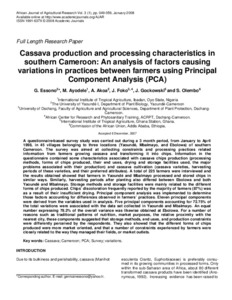| dc.contributor.author | Essono , G.G. |
| dc.contributor.author | Ayodele, M. |
| dc.contributor.author | Akoa, A. |
| dc.contributor.author | Foko, J. |
| dc.contributor.author | Gockowski, J. |
| dc.contributor.author | Olembo, S. |
| dc.date.accessioned | 2019-12-04T11:14:33Z |
| dc.date.available | 2019-12-04T11:14:33Z |
| dc.date.issued | 2008 |
| dc.identifier.citation | Essono, G., Ayodele, M., Akoa, A., Foko, J., Gockowski, J. & Olembo, S. (2008). Cassava production and processing characteristics in southern Cameroon: An analysis of factors causing variations in practices between farmers using Principal Component Analysis (PCA). African Journal of Agricultural Research, 3(1), 049-059. |
| dc.identifier.isbn | Books and Book Chapters |
| dc.identifier.issn | 1991-637X |
| dc.identifier.uri | https://hdl.handle.net/20.500.12478/2793 |
| dc.description.abstract | A questionnaire-based survey study was carried out during a 3 month period, from January to April 1998, in 45 villages belonging to three locations (Yaoundé, Mbalmayo, and Ebolowa) of southern Cameroon. The survey was aimed at collecting constraints and processing practices related information from farmers growing cassava and transforming it into chips. Information in the questionnaire contained some characteristics associated with cassava chips production (processing methods, forms of chips produced, their end uses, drying and storage facilities used, the major problems associated with their production) and cassava cultivation (cassava varieties, harvesting periods of these varieties, and their preferred attributes). A total of 225 farmers were interviewed and the results obtained showed that farmers in Yaoundé and Mbalmayo processed and stored chips in similar ways. Similarly, harvesting periods after planting also differed between Ebolowa and both Yaoundé and Mbalmayo. Storage methods and storage facilities were mainly related to the different forms of chips produced. Chips’ discoloration frequently reported by the majority of farmers (87%) was as a result of their insufficient drying. Principal component analysis was implemented to determine those factors accounting for differences observed in farmers’ practices. Eleven principal components were derived from the variables used in analysis. Five principal components accounting for 72.75% of the total variations were associated with the data set collected in Yaoundé and Mbalmayo. An equal number expressing 78.2% of the overall variance was likewise obtained at Ebolowa. For a number of reasons such as traditional patterns of nutrition, market purposes, the relative proximity with the nearest city, these components suggested that storage methods, end uses, and production constraints were differently perceived by the respondents. They also showed that the different forms of chips produced were more market oriented, and that a number of constraints experienced by farmers were closely related to the way they managed their fields, or market outlets. |
| dc.description.sponsorship | African Union |
| dc.language.iso | en |
| dc.subject | Cassava |
| dc.subject | Pca |
| dc.subject | Survey |
| dc.subject | Variations. |
| dc.title | Cassava production and processing characteristics in southern Cameroon: an analysis of factors causing variations in practices between farmers using Principal Component Analysis (PCA) |
| dc.type | Journal Article |
| dc.description.version | Peer Review |
| cg.contributor.affiliation | International Institute of Tropical Agriculture |
| cg.contributor.affiliation | Université de Yaoundé |
| cg.contributor.affiliation | Université de Dschang |
| cg.contributor.affiliation | African Center for Research and Phytosanitary Training |
| cg.contributor.affiliation | Africa Union Commission |
| cg.coverage.region | Africa |
| cg.coverage.region | Central Africa |
| cg.coverage.country | Cameroon |
| cg.authorship.types | CGIAR and developing country institute |
| cg.iitasubject | Handling, Transport, Storage And Protection Of Agricultural Products |
| cg.iitasubject | Cassava |
| cg.iitasubject | Markets |
| cg.howpublished | Formally Published |
| cg.accessibilitystatus | Open Access |
| local.dspaceid | 93894 |

